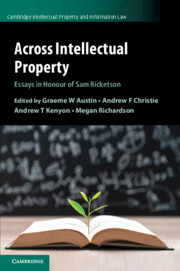Book contents
- Across Intellectual Property
- Cambridge Intellectual Property and Information Law
- Frontispiece
- Across Intellectual Property
- Copyright page
- Contents
- Notes on Contributors
- Introduction
- Part I Across Regimes
- 1 A Matter of Sense
- 2 Overlap and Redundancy in the Intellectual Property System
- 3 Rethinking the Relationship between Registered and Unregistered Trade Marks
- 4 Publication in the History of Patents and Copyright
- 5 Of Moral Rights and Legal Transplants
- Part II Across Jurisdictions
- Part III Across Disciplines
- Part IV Across Professions
- Laudatio
- Cambridge Intellectual Property and Information Law
1 - A Matter of Sense
What Intellectual Property Rights Protect
from Part I - Across Regimes
Published online by Cambridge University Press: 27 March 2020
- Across Intellectual Property
- Cambridge Intellectual Property and Information Law
- Frontispiece
- Across Intellectual Property
- Copyright page
- Contents
- Notes on Contributors
- Introduction
- Part I Across Regimes
- 1 A Matter of Sense
- 2 Overlap and Redundancy in the Intellectual Property System
- 3 Rethinking the Relationship between Registered and Unregistered Trade Marks
- 4 Publication in the History of Patents and Copyright
- 5 Of Moral Rights and Legal Transplants
- Part II Across Jurisdictions
- Part III Across Disciplines
- Part IV Across Professions
- Laudatio
- Cambridge Intellectual Property and Information Law
Summary
To the elemental question of what is the nature of intellectual property, the conventional answer is that it is ‘intangible’ and hence has no physical existence. This is because, it is said, there is a fundamental dichotomy between the immaterial subject matter that is protected by an IP right and its embodiment in some material object. This chapter revisits the elemental question and comes to the conclusion that the conventional view mis-states the position. In particular, while it is true that IP laws recognise something like the tangible/intangible duality, properly understood the rights granted by those laws do not attach to the immaterial subject matter; rather, they attach to the material object in which the subject matter is embodied. More specifically, while the class of things in respect of which IP protection may be granted includes intangibles, it also includes tangibles. Moreover, the things in that class are material – in that they are perceptible by a human sense.
Keywords
- Type
- Chapter
- Information
- Across Intellectual PropertyEssays in Honour of Sam Ricketson, pp. 11 - 25Publisher: Cambridge University PressPrint publication year: 2020

